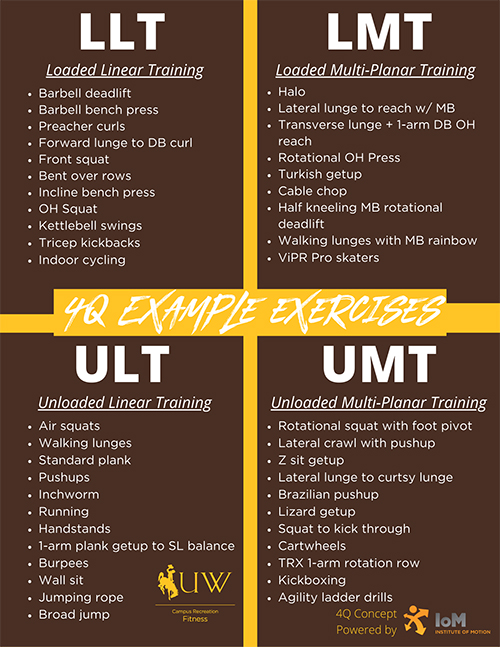Muscle Groups Involved
-
Hip Hinge Tilt (LLT)
-
Stir the Pot (LMT)
-
Helicopter Squat (LMT)
-
Seated Teeter Totter (LMT)
-
Quadruped Underhand Drag (LMT)
-
Loaded Bird Dog (LLT)
-
Swoop Up to Chop (LMT)
-
Backward Kayak (LMT)
-
Staggered Stance Shovel (LMT)
Equipment Involved
-
Hip Hinge Tilt (LLT)
-
Stir the Pot (LMT)
-
Helicopter Squat (LMT)
-
Seated Teeter Totter (LMT)
-
Quadruped Underhand Drag (LMT)
-
Loaded Bird Dog (LLT)
-
Swoop Up to Chop (LMT)
-
Backward Kayak (LMT)
-
Staggered Stance Shovel (LMT)
Introduction to 4-Quadrant (4Q) Methodology**
You may notice that each exercise has three letters next to its name, either LLT, ULT, LMT, or UMT. These abbreviations correspond to the 4-Quadrants below that can describe any type of movement.
LLT = Loaded Linear Training
ULT = Unloaded Linear Training
LMT = Loaded Multi-planar Training
UMT = Unloaded Multi-planar Training
“Linear Training” involves actions that occur in the sagittal plane, which divides the body into left and right halves. We can train with or without load in this plane of motion.
“Multi-planar Training” involves actions that occur in the other two planes of motion; the frontal plane which divides the body into a front and back half, and the transverse plane which divides the body into a top and bottom. Moving sideways incorporates moving through the frontal plane while rotating involves moving through the transverse plane. We can train with or without load in these other two planes of motion.


4Q Benefits**
Training in each quadrant involves certain unique benefits and adaptations. Below
is a short list of benefits to each quadrant and some example exercises.
LLT = Greater recruitment of fast-twitch muscle fibers, ideal for hypertrophy and
max strength, high intra-muscular coordination, develop strength “close to the body.”
Exercise examples: barbell deadlift, deadlift, bicep curls, forward lunge to dumbbell
curl, front squat, bent over rows, incline bench press, overhead squat, kettlebell
swings, tricep kickbacks, indoor cycling.
ULT = Greater recruitment of stabilizing muscles, become “bodyweight strong,” increase
relative strength, improve “core” strength. Exercise examples: air squats, walking
lunges, standard pushups, inchworm, running, handstands, burpees, wall sits, jumping
rope, broad jumps.
LMT = Become “cowboy/rancher strong,” high inter-muscular coordination, become strong
in lengthened positions and odd-positions, high functional carryover to life and sport.
Exercise examples: Lateral lunge to forward reach with medicine ball, transverse lunge
to 1-arm dumbbell overhead reach, squat to rotational overhead press, Turkish getup,
cable chop, half-kneeling medicine ball rotational deadlift.
UMT = Become “bodyweight strong” in multiple positions and odd postures, increase
injury resistance and tissue tolerance at end ranges-of-motion. Exercise examples:
rotational squat with foot pivot, lateral crawl with pushup, Z getup, lateral lunge
to curtsy lunge, Brazilian pushup, lizard getup, squat to kick through, cartwheels,
TRX® 1-arm rotation row, kickboxing, agility ladder drills.
*Disclaimer: The University of Wyoming is not responsible for injuries, accidents, or illness that may occur during virtual offerings and fitness activities. Participants understand and agree that their use of these services is at their own risk. In addition, any information shared from other sources is for you to access at your discretion. The University of Wyoming is not accountable for the results of the content shared.
**4Q Concept Powered by IoM (Institute of Motion)

